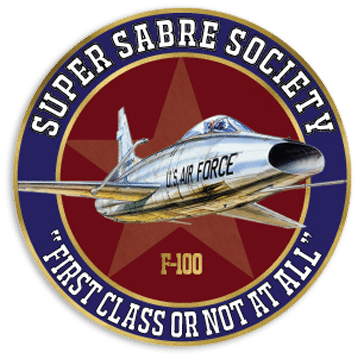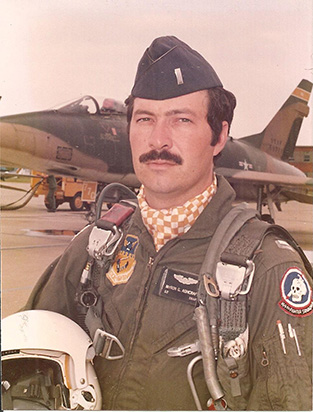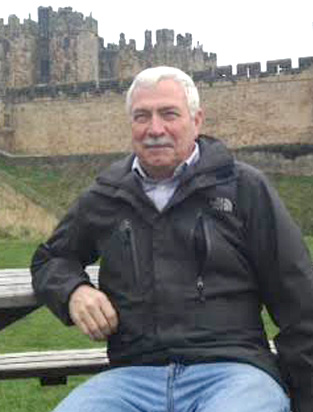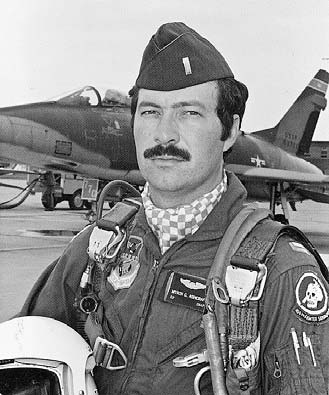In his words…
“I started flying at Ohio State University in 1968, getting my Private, Commercial, Instrument, and Flight Instructor Certificates quickly. That allowed me to gain time and experience as I paid my way through college as a flight instructor. I hadn’t planned on joining the military, but after college, I enlisted in the Ohio Air National Guard and they sent me to Air Force Pilot Training.
Even though I had about 1000 hours of civilian flying time I was treated as a brand-new pilot in the US Air Force. I went through their initial flight training in Columbus, Mississippi and then went to Tucson, AZ for six months of F-100 training. Many of my instructors had just returned from combat tours in Viet Nam so the instruction was first-rate. When the Thunderbirds flew the F-100’s, I thought that was the prettiest paint job on any airplane I had ever seen. I couldn’t wait to fly the Hun.
I was able to fly the F-100 for four years before our Guard unit was selected to receive C-130s instead of the fighters. We went from a small fighter, being by yourself or with one other pilot, to what seemed like a cast of thousands. You were inundated with a co-pilot, a navigator, a flight engineer, and one or two loadmasters depending on the mission. It was more management than just flying the airplane.
Most of the old fighter pilots hated being in the C-130, but it was a great airplane to fly. We did a lot of low levels, air-drops, and assault landings. The assault landings were accomplished on 60 foot wide runways 3000 feet long. In the F-100 or later in my career in the Boeing 777 we would have had a heart attack if the field was less than 9,000 feet long. But in those days doing the assault landings was big fun.
I ended up with over 5000 hours in the C-130 and I have some very fond memories of where we went. We flew it all over the world. I spent lots of time lots of time in South America and learned early on that in South America they’ll clear you for whatever you ask for. So the only way to keep from hitting the hills is not to ask for something stupid.
My most memorable flight in the F-100 was in an F model with an unqualified guy in the back seat. We were scheduled to fly in an Air Show in a formation to honor Colonel Alan P. Tappan, one of those responsible for locating an Air National Guard unit in Mansfield, Ohio. The plan was to fly our F-100s in the formation of “A” and “T”. I was scheduled to be the last in the formation as the bottom of the “T”.
We had one aircraft abort ahead of me, so I was moved up one position to the middle of the stem of the “T”. That left one guy flying behind me in the formation. As we practiced at about 2500 AGL (Above Ground Level) the guy behind me advised that I was streaming fuel and should break out of the formation and land immediately. I pulled out of the formation, pushed up the throttle, but nothing happened. No response at all. It seemed like the engine was frozen at about 3/4 power. I figured I had just enough altitude to make it back to the field, providing nothing else went wrong. I did a final turn at about 190 knots in case we had to jump out with the engine still not providing much thrust.
To make a long story short, when I closed the throttle to flare, the engine quit. We used to laugh about it being better to be lucky than good. That day I was really lucky. The fuel heater had ruptured internally and was allowing the oil into the fuel and of course fuel into the oil. The reduced pressure caused the pressurization and dump valve to open and stream fuel. Of course, the crowd loved the mock fire response to a supposed in-flight emergency.
My best military assignment was toward the end of my 33 years in the Air National Guard. It was in the year following the 9/11 attack and the big Air Force was looking for commanders for their Expeditionary Air Wings. I volunteered and was selected to command the 376th in Bishkek, Kyrgyzstan. I knew nothing about the assignment, the base or even the country. When I arrived I discovered that I had inherited a combat wing composed of Mirage 2000s and Marine F-18s. Support aircraft included KC-135s, C-130s, and rescue helicopters. I also discovered that the best job in the US Air Force is being a combat wing commander. Nothing even comes close, in my humble opinion. My team and I organized a transition to F-16s and a KC-10 while keeping the C-130s and rescue helicopters.
We worked with South Korea, Denmark, Norway, The Netherlands, France, Italy, Australia, and Spain. We also hosted the Marines. All operations were in support of the war in Afghanistan. There were lots of moving parts. In the end, I managed not to lose any people or aircraft.
As the saying goes, “I would rather be lucky than good.””
The Man…
You might say that Brigadier General Myron G. Ashcraft’s leadership skills were evident early in life. As a youth, he was active in the 4-H and Future Farmers of America. He served as president of the local Junior Fair Board, Junior Leadership Club, and River View FFA. While with the local extension office, he worked with other U.S. Department of Agriculture agencies including the Soil Conservation Service and the Hydrological Station. He was involved in the total extension program, agriculture, home economics, working with farmers, homemakers, 4-H members, and advisors.
At Ohio State University he majored in Agriculture Education. During college, Myron worked as a flight instructor for Ohio State at Don Scott Field from 1969 till graduation in 1971.
After enlisting in 1970 Ashcraft served the Ohio Air National Guard for the next 33 years. His leadership in the ANG was legendary. In a report in 2010, he was commended for serving as Ohio’s Air Guard chief of staff in a year that showed the Ohio Air National Guard leading the country in recruiting efforts and exceeded the goal of 100 percent manning, largely due to the tuition benefits offered through the Ohio National Guard Scholarship Program.
During this fiscal year, the Ohio Air Guard, alongside its active-duty counterparts, began support of the Air Force’s new Expeditionary Aerospace Force concept. Ohio’s complement of refueling, airlift, fighter aircraft and support units augmented flight and support packages tailored to support warfighting commanders in chief. During this reporting period, almost every unit in the Ohio Air National Guard deployed members around the world to support Air Force missions. Ohio’s Aerospace Expeditionary Force members were vital to meeting contingency requirements in Bosnia, Kosovo, Turkey, Kuwait, and Qatar. Airmen also supported other Air Force operations in countries such as England, France, Hungary, and Italy. (source: HQ Ohio National Guard, Air Force Order of Battle; Created: 29 Sep 2010)
In 2010, Gen. Ashcraft skated the North Shore Inline Marathon at the age of 61 and placed in the upper third of entries. He currently works with Ohio Dreams Action Sports Camp, an Ohio sports camp that specializes in high energy sports such as BMX bike racing, freestyle skiing, and snowboarding, and skateboarding. At camp, he is fondly known as “The General”.
After retiring from 35 years with United Airlines, he accepted a position with FlightSafety International. He is currently a pilot instructor teaching the Falcon 2000, a corporate business jet. Ironically, the facility is located only 300 yards from where he trained to be a flight instructor in 1969.
Myron G. Ashcraft, BGen USAF, Ret., “Headed West” on December 12, 2023.
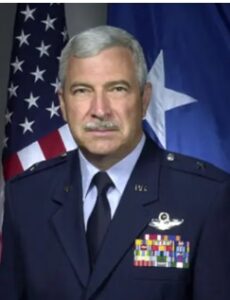 “In the quiet embrace of his home in Lexington, Ohio, surrounded by those that loved him, on a sunny winter day, Retired Brigadier General Myron G. Ashcraft, an exemplary military leader, skilled aviator, and devoted family man, completed his final earthly mission on December 12th, 2023, following a courageous battle against cancer. Born on June 17, 1949, Myron peacefully departed at the age of 74.
“In the quiet embrace of his home in Lexington, Ohio, surrounded by those that loved him, on a sunny winter day, Retired Brigadier General Myron G. Ashcraft, an exemplary military leader, skilled aviator, and devoted family man, completed his final earthly mission on December 12th, 2023, following a courageous battle against cancer. Born on June 17, 1949, Myron peacefully departed at the age of 74.
Myron, the only child of the late James and Naomi Ashcraft, spent his early years on the family farm in Warsaw, Ohio. Amidst the vast horizons, he nurtured a love for aviation that would become the guiding force of his extraordinary journey. Graduating from The Ohio State University with a Bachelor of Science in Agriculture in 1971, Myron’s commitment to excellence soared when he was recognized as the Outstanding Civil Flight Student in 1969.
Responding to the call of duty, Myron enlisted in the Ohio Air National Guard in 1970. A journey that spanned over three decades saw him rise through the ranks, achieving the distinguished rank of Brigadier General. As a seasoned command pilot, Myron logged over 5,000 flight hours across various aircraft, including T-41, T-37, T-38, F-100, and C-130B.
Myron’s illustrious military career included commanding the 179th Operations Support Flight and making history as the first traditional guardsman to lead the Operations Group. His impact transcended borders as he commanded an Air Expeditionary Wing in the former Soviet Union, overseeing combat operations in Afghanistan.
Educationally astute, Myron earned a Master’s degree in Business Administration from Auburn University in 1982, a Master of Arts degree in National Security and Strategic Studies from the Naval War College in 1989, and completed CAPSTONE in 2002.
Among his numerous accolades are the Bronze Star, Meritorious Service Medal, Air Medal, and the Ohio Distinguished Service Medal. Retiring as a Brigadier General on October 29, 1999, Myron’s military legacy is one of valor, dedication, and leadership.
Myron’s love of aviation continued in the civilian world where he had a 35 year career with United Airlines, achieving more than 20,000 flight hours. He flew many aircraft for United and retired on one of their largest jets the Boeing 777, flying mostly long-haul flights to his favorite cities, including, London, Frankfurt, and Bejing.
Myron’s commitment extended beyond the military and civilian flying realm; he was a dedicated family man. He leaves behind his loving wife of 45 years, Pam Ashcraft, a partnership founded on shared adventures and enduring love. Their legacy continues through their two sons, Christopher and Phillip James Ashcraft (Michelle Ashcraft), and grandchildren Hannah Archibald and Landen Ashcraft.
In tandem with his son Chris, Myron co-founded Ohio Dreams Action Sports Camp, a testament to his belief in dreams. His impact on the lives of thousands of young action sports enthusiasts and music lovers will most certainly be felt for generations to come. The unbreakable friendships, loves, and shared memories are all because of him.
Visitation to celebrate Myron’s life will be held Monday December 18, 2023 from 4:00-8:00 PM at the Lexington Avenue Snyder Funeral Home, where funeral services will be held Tuesday December 19, 2023 at 11:00 AM with Pastor Chad Berry officiating. Burial will follow in Lexington Cemetery.
As we bid farewell to a man who touched the skies and our souls, Brigadier General Myron G. Ashcraft’s legacy will endure—a testament to a life lived with courage, integrity, and an unwavering passion for the boundless horizons of the sky.
To send flowers to the family or plant a tree in memory of Retired Brigadier General Myron, please visit our floral store.”(1)
Source: (1) https://www.snyderfuneralhomes.com/obituaries/Retired-Brigadier-General-Myron-Ashcraft?obId=30108545
